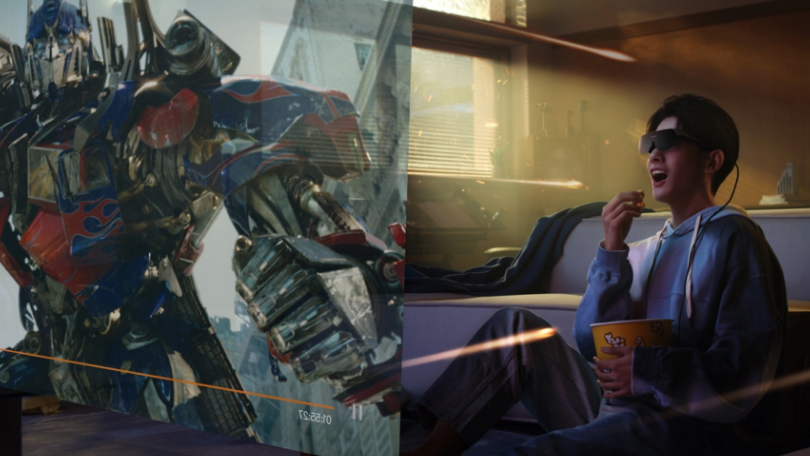
In December, Huawei announced its new action on the AR track at the winter full scene new product conference: HUAWEI, Huawei's first intelligent film spectator
Vision Glass will support Huawei to complete the full scene strategic layout in the direction of segmentation. HUAWEI
Vision
Glass supports the projection of the equivalent 4m 120 inch virtual giant screen in the air, which is equivalent to enlarging our mobile phone screen by 20 times. It can be plugged in and used at home, on the way to work, or on the way to travel. It is equivalent to putting a 120 inch giant screen in your pocket to enjoy immersive giant screen viewing anytime and anywhere. | What stage is AR at? IDC data shows that since last May, domestic VR manufacturers have significantly accelerated the pace of product iteration, and the global VR/AR terminal shipments will also exceed the 10 million mark in 2021, reaching 11.23 million units, a year-on-year increase of 92.1%, including 10.95 million VR head display devices and 280000 AR devices. According to the latest prediction of the agency, the total investment scale of China's AR/VR will exceed 12 billion US dollars in 2026, accounting for 24.4% of the world's total, and the market volume is second only to that of the United States. | From the perspective of the timeline, Huawei has started its layout in the VR field since 2016. According to incomplete statistics, Huawei's layout direction covers VR hardware, AR hardware, underlying technology and Cloud
VR and other fields, and introduced several international experts to take charge of project research. According to data, Huawei and its affiliated companies currently have more than 110 patent applications in the field of AR glasses, of which invention patents account for more than 95%. Technically, Huawei's patent layout in this field mainly focuses on the display, image reading, mechanical mode conversion, non optical accessories, near eye display, optical systems and other related fields. HUAWEIVision released by Huawei
Glass, although its appearance is not very different from that of ordinary sunglasses, has made a breakthrough in the combination of AR technology, and is based on HarmonyOS
3. The PC mode realizes functions such as application projection, and projects the effect of a 120 inch screen in an equivalent 4m virtual space.
This is the first time Huawei glasses have been combined with AR display technology.
| At present, in the AR/VR track, in addition to Huawei
many head companies have also launched a layout in related fields. In November this year, the patent of Apple's "Predictive Central Concave Virtual Reality System" was granted, and the speed increase in the patent has been regarded as a precursor to the landing of Apple's VR products. Google and Meta have also recently updated the patents of head display devices. In terms of domestic enterprises, ByteDance acquired PICO, a VR company, last year, with an acquisition amount of 9 billion yuan, which is the highest in the industry. In the direction of product research and development, we focus on VR sports and fitness, VR video, VR entertainment and VR creation. Alibaba's Tmall also launched a 3D shopping service on the Double 11 Festival, which uses virtual characters to shop. From the perspective of the competition pattern, the number of players entering the VRAR industry this year has increased significantly compared with previous years. Many start-ups and traditional manufacturers who have not set foot in relevant product lines have launched or plan to launch new VR product trials. From the perspective of product characteristics, most of the new VR products are all-in-one machines, among which there are many head displays using the pancake display scheme, all aiming at the consumer market. The content ecology focusing on games and fitness scenes is gradually established, and the shipment volume of the consumer market continues to increase.
In 2022, VR shipments will reach 15.73 million units, with a year-on-year growth of 43.6%. It is not difficult to infer that the gradual outbreak of downstream demand is also driving the upstream supply chain to mature. TCL Huaxing, Shenzhen Tianma and Vicino announced in the third quarterly report that they have some layout or reserves in the VR field. Omdia, a research institute, believes that the overall capacity utilization rate of panel plants fell to 69% in the third quarter of this year, but the demand for high-end panels such as AR/VR near eye displays is growing. The shipment volume of AR/VR near eye display will increase from 11.77 million dollars in 2021 to 18.406 million dollars in 2022. Augmented reality is expected to become one of the new engines of the display industry in the future.
| What are the industry challenges?
IDC forecasts that China's AR/VR market will maintain a high growth rate of 42.2% CAGR from 2021-2026, surpassing other eight regions such as the United States and Western Europe in terms of growth, ranking first in the world. However, from the perspective of industry challenges, consumers' acceptance of hardware and content is still the most difficult. The obstacles for VR devices to open the C-end market mainly involve immersion, comfort, interoperability and economy. In terms of immersion, consumers pursue multiple senses such as vision, hearing and touch to enhance the fidelity of virtual scenes. In terms of comfort, consumers attach importance to the wearing experience, including the weight and size of the equipment, reducing the vertigo, etc. Interoperability refers to the interconnection with content, ecology and users. Economy includes purchase cost and time cost required for equipment deployment. In addition, there are two difficulties in the construction of content ecology. First, compared with PC and mobile devices, the penetration rate of VR hardware is not enough, and consumers' motivation to continue to consume content is also slightly insufficient. Second, VR hardware manufacturers are numerous, and the devices are complex and diverse. Content providers need to adapt and optimize different hardware, and the cost is high.





